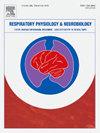Protective effect of isopimpinellin on ovalbumin-induced airway inflammation and oxidative stress in mouse model of asthma
IF 1.6
4区 医学
Q3 PHYSIOLOGY
引用次数: 0
Abstract
Background
Asthma is a chronic airway disease characterized by immunological dysregulation that causes sustained inflammation, leading to aberrant airway narrowing and mucus production. Isopimpinellin (IP) is a naturally occurring furanocoumarin, generated by an association of coumarin and a furan ring, possessing antifungal, antibacterial, and antioxidant properties; however, its potential in asthma treatment has not been investigated. This study sought to evaluate the anti-inflammatory and antioxidant effects of IP in an ovalbumin (OVA)-induced murine model of asthma.
Methods
Mice were grouped into four groups (n = 8 per group): control, OVA, and IP-treated (35 and 70 mg/kg). At the end of the experiment, lung oxidative stress, inflammation, and histopathological changes were evaluated.
Results
IP treatment significantly ameliorated airway oxidative stress by decreasing the concentration of malondialdehyde (MDA) and increasing the levels of antioxidants, including glutathione (GSH), catalase (CAT), and glutathione peroxidase (GPx); reduced inflammatory cell infiltration; mitigated histological changes; and decreased levels of IL-4, IL-13, and IgE. Additionally, IP prevented NF-κB phosphorylation. This study is the first examination of the anti-asthmatic properties of IP in allergic asthma in murine models.
Conclusion
Our data indicate that IP may function as an anti-asthmatic medication via regulating oxidative stress and inflammation.
异opopimpellin对卵清蛋白诱导的哮喘小鼠气道炎症和氧化应激的保护作用
哮喘是一种慢性气道疾病,其特征是免疫失调,引起持续炎症,导致异常气道狭窄和粘液产生。异opopimpinellin (IP)是一种天然存在的呋喃香豆素,由香豆素和呋喃环结合产生,具有抗真菌、抗菌和抗氧化特性;然而,其在哮喘治疗中的潜力尚未被研究。本研究试图在卵清蛋白(OVA)诱导的哮喘小鼠模型中评估IP的抗炎和抗氧化作用。方法smice分为对照组、OVA组和ip处理组(35和70 mg/kg),每组 = 8只。实验结束时,观察大鼠肺氧化应激、炎症及组织病理学变化。结果sip治疗通过降低丙二醛(MDA)浓度和提高抗氧化剂水平,包括谷胱甘肽(GSH)、过氧化氢酶(CAT)和谷胱甘肽过氧化物酶(GPx),显著改善气道氧化应激;炎症细胞浸润减少;减轻组织学改变;IL-4、IL-13和IgE水平降低。此外,IP阻止NF-κB磷酸化。本研究首次在小鼠变应性哮喘模型中检测了IP的抗哮喘特性。结论黄芪多糖可能通过调节氧化应激和炎症反应发挥抗哮喘作用。
本文章由计算机程序翻译,如有差异,请以英文原文为准。
求助全文
约1分钟内获得全文
求助全文
来源期刊
CiteScore
4.80
自引率
8.70%
发文量
104
审稿时长
54 days
期刊介绍:
Respiratory Physiology & Neurobiology (RESPNB) publishes original articles and invited reviews concerning physiology and pathophysiology of respiration in its broadest sense.
Although a special focus is on topics in neurobiology, high quality papers in respiratory molecular and cellular biology are also welcome, as are high-quality papers in traditional areas, such as:
-Mechanics of breathing-
Gas exchange and acid-base balance-
Respiration at rest and exercise-
Respiration in unusual conditions, like high or low pressure or changes of temperature, low ambient oxygen-
Embryonic and adult respiration-
Comparative respiratory physiology.
Papers on clinical aspects, original methods, as well as theoretical papers are also considered as long as they foster the understanding of respiratory physiology and pathophysiology.

 求助内容:
求助内容: 应助结果提醒方式:
应助结果提醒方式:


